#Kay Adshead
Explore tagged Tumblr posts
Text




Kay Adshead (Cathy) and Ken Hutchison (Heathcliff) in "Wuthering Heights" 1978 version.
#kay adshead#ken hutchison#wuthering heights#emily bronte#wuthering heights 1978#wuthering heights bbc
18 notes
·
View notes
Text
#wuthering heights#emily bronte#book to film#book to tv#emily brontë#literary polls#film adaptations#tv adaptation#laurence olivier#timothy dalton#heathcliff#ralph fiennes#ken hutchison#merle oberon#juliette binoche#tom hardy#james howson#kaya scodelario#kay adshead#bronte sisters#british literature#classic literature#classic novels#gothic novel#19th century literature#1930s movies#1970s movies#1990s movies#2010s movies#classic books
16 notes
·
View notes
Text
















The Kiss of Death (1977)
6 notes
·
View notes
Text

Seen in 2024:
The Kiss of Death (Mike Leigh), 1977
#films#movies#stills#The Kiss of Death#Mike Leigh#Kay Adshead#UK#1970s#seen in 2024#TV#Play for Today
2 notes
·
View notes
Text
04x21 - Trouble And Strife
A group of young children watch as Malcolm and Pete tend to a beaten wife, Joanna Mancini who is sat on the wall outside her house. She tells them she's separated from her husband but he's inside the house with a motorbike chain. Pete says they can arrest him for ABH but she will have to go to court if he pleads not guilty. After some hesitation she nods, agreeing that she'll see it through.
Pete and Malcolm knock on the door and shout for the husband to let them in. A neighbour tells Malcolm that she always has trouble with her husband and that she's a martyr to him and doesn't look after her kids. Joanna becomes defensive and tells Malcolm repeatedly to make her go away. She ends up threatening to give the neighbour a black eye and reveals that she's also pregnant. One of her children, Wayne, tells the neighbour to 'put a sock in it'.
Pete goes round the back to try and get in and Malcolm offers to break a window to gain access when she repeats that she wants her husband locked up. She refuses as 'her boys will be back in a minute' She looks around for Wayne who has disappeared and shouts his name a couple of times. She then sees the car and gets an idea, shouting for her husband. If he doesn't let her in, she'll trash his car. Pete returns having not been able to get in just as Joanna locks herself in the car and shouts that she'll destroy it.
The husband, played by Brian Capron, finally appears through the upstairs window. He threatens to drop Joanna's sewing machine if she doesn't get out of his car. She then threatens to smash his face if he does. They continue to argue before she speeds off - almost running the two officers over - though she stops just before the wall. She reverses back to the house to see if her husband has changed his mind. When he hasn't, she drives into a nearby wall. The husband shouts threats to kill her and then drops her sewing machine from the window. Joanna walks slowly back towards the house where Mr Mancini is throwing more things from the bedroom. Pete offers to break in and stop him and this time she agrees.
Once inside, Pete shouts for Mr Mancini as Malcolm looks around the house. "Do you reckon he's still got that bike chain....?" They head upstairs and Mancini is heard in another room. They ask him to come out quietly and find the window open, thinking he's done a runner. They search the area and can't find him so return to Joanna. It's a rare exchange of opinions for these two. Malcolm thinks they're as bad as each other and that the Mancini's feed off drama, but Pete feels sorry for Joanna and hates wife batterers.
As they have a cup of tea, the boys hear the door go. Thankfully it's just Wayne returning. Joanna makes him a drink and suggests he go watch Spurs in the next room. Pete takes offense when Wayne calls them a bunch of hairdressers. "Oi, my cousin plays for that team!" "My dad told me not to talk to policemen." "Not a lawyer is he?"

I'm pondering what she means by 'a couple of hours' - sex chat line or actual escort work? Either way, I love how both boys react 🤣🤣🤣)
Joanna starts to cry and Pete nopes out of it, going to see what the football score is. Joanna repeats that her husband will kill her and asks for police protection. Malcolm has to tell her that she's going to be arrested for criminal damage to the wall. She can't believe it and thinks Mancini should be the one arrested. Pete explains that her husband will likely press damages against her for criminal damage to his car if she pursues an ABH charge against him. Wayne keeps calling for her attention and she tells him to shut up and he snaps the same back at her.
Pete goes upstairs with Wayne to get his coat and notices fingerprints on the loft hatch. Mancini is inside which explains how he vanished. Pete tries to speak to him but Mancini is stood on the loft hatch so Pete goes down to get the saw he spotted to cut his way into the loft once Joanna gives him permission. "Right Mr Mancini, I'm coming up!" Once Pete tries to cut his way inside he finds that the loft hatch now opens freely. He shines the torch around, calling for Mancini. Joanna shouts his name and says she's going to get a knife and will kill him. Pete pushes her into the kitchen and tells her to stay.
Malcolm doesn't want to stick his head through the gap because it could be a booby trap. Pete shrugs, saying he doesn't want to still be there tomorrow and Mancini won't be talked down. He then admits he doesn't fancy it either and sarcastically suggests getting Cryer to come and offer Mancini a cup of tea. Both are unnerved by the silence from Mancini but Pete climbs the stairs again and shines his torch around. "I'm not going to hurt you so don't do anything nasty. I'm just coming up for a little chat." He reminds him to keep calm so they can sort things out properly. The loft is dark and Mancini remains silent. Pete looks around it with his torch and shouts to Malcolm that he's not there. As he starts to leave, Mancini leaps on him and they burst through the ceiling with Mancini throttling him! Malcolm quickly gets the chain from Pete's neck and eases him down but Mancini falls on top of them.






The boys manage to grab him and arrest him but Joanna starts assaulting them for arresting him! Malcolm manages to get her away and Mancini threatens them for touching Joanna. Pete deals with him in a way that Burnside would be proud of.

In the bedroom Joanna um... mixes...Malcolm's sleeves with the kitchen mixer and Wayne is holding a toasting fork. Pete playfully admonishes Malcolm for not having sorted Joanna yet because 'she's just a woman' and he gets distracted by a goal attempt on the TV. It becomes a corner and... yeah. He's not helpful.
I can't do this scene justice in words, you really need to watch the following video.
The thing I want most in the world now is to see Smithy and Callum redo this scene because you KNOW Smithy would make Callum wait until he turned the power off when West Ham was playing.
The boys arrest both of the Mancini's and Joanna asks Malcolm to call an ambulance because she thinks her waters are going to break. Malcolm doesn't believe a second of it as he leads her out... just as the Mancini boys turn up and ask "What are you doing with my mum?"

#trouble and strife#04x21#the bill#pete ramsey#malcolm haynes#eamonn walker#nick reding#brian capron#kay adshead
1 note
·
View note
Photo



Wuthering Heights ep. 2 (1978) dir. Peter Ammond
#quality sucks but it is what it is. I really wanted to gif this scene#her espression is hearthbreaking#(for context this is after heathcliff's return)#wuthering heights#wuthering heights 1978#emily bronte#catherine earnshaw#heathcliff#kay adshead#ken hutchison#serie tv#edit#wh edits
173 notes
·
View notes
Photo









“The Hound of the Baskervilles” (1982)
Tom Baker as Sherlock Holmes Terence Rigby as Dr. John H. Watson Nicholas Woodeson as Sir Henry Baskerville Caroline John as Laura Lyons Will Knightley as Dr. Mortimer Kay Adshead as Beryl Stapleton Christopher Ravenscroft as Stapleton
youtube
#the hound of the baskervilles#tom baker#terence rigby#nicolas woodeson#caroline johns#will knightley#kay adshead#christopher ravenscroft#Sherlock Holmes#dr. watson
39 notes
·
View notes
Photo

Operaatio Julie / Operation Julie (1985) Vestron Video International https://www.videospace.fi/release/operaatio_julie_nauha_vestron_video_international_finland
#Videospace#nauha#Operaatio Julie#Operation Julie#Bob Mahoney#Colin Blakely#Kay Adshead#John Ainley#VHS tapes#VHS art#VHS cover
1 note
·
View note
Note
Weird request, but do you have any faceclaims that are gingers? It's so hard to find ginger faceclaims of different ethnicities, body types, etc.
Hey anon! I’m not sure if you only wanted diverse faceclaims only but below are 200+ ginger faceclaims and I have noted the diverse suggestions. Please let me know if you’d like more specific suggestions for example from a certain age range.
Big thanks to @katherine-mcnamara!
Non-binary:
Nicky Endres (1982) Korean - non-binary, transfeminine, genderqueer and queer - they/she.
Olly Alexander (1990) - non-binary and gay - he/him.
Kaitlyn Alexander (1992) - non-binary - they/them.
Maggie McGill (?) - is non-binary, queer and fat/plus size- she/they,
Women:
Joy Behar (1942)
Sondra Currie (1947)
Becky Ann Baker (1953)
Kay Adshead (1954)
Julianne Moore (1960)
Carol Alt (1960)
Andrea Arnold (1961)
Marcia Cross (1962)
Cheryl Hawker (1962) - is fat/plus size.
Amy Yasbeck (1962) Lebanese / Irish.
Kate Walsh (1967)
Molly Ringwald (1968)
Debra Messing (1968)
Catherine Tate (1969)
Stephanie Belding (1971)
Brigid Brannagh (1972)
Nathalie Boltt (1973)
Alyson Hannigan (1974) Ashkenazi Jewish / Irish.
Amy Adams (1974)
Tina Campbell (1974) African-American.
Alicia Witt (1975)
Jen Richards (1976) - is trans and bisexual.
Isla Fisher (1976)
Lauren Ambrose (1978)
Natasha Lyonne (1978) Ashkenazi Jewish.
Itziar Castro (1977) - is a lesbian.
Jaime Ray Newman (1978) Ashkenazi Jewish.
Rachelle Lefevre (1979)
Ruth Connell (1979)
Nur Fettahoğlu (1980) Turkish.
Sarah Drew (1980)
Bridget Regan (1982)
Bronagh Waugh (1982)
Lotte Verbeek (1982)
Alexandra Breckenridge (1982)
Kate Mara (1983)
Tuğçe Kumral (1983) Turkish.
Lynsey Bartilson (1983) Ashkenazi Jewish / Norwegian, Dutch, mix of English, Irish, and French.
Magda Apanowicz (1985)
Emily Beecham (1985)
Deborah Ann Woll (1985)
Natalya Rudakova (1985)
Sarah Power (1985)
Our Lady J (1985) - is trans.
Mary Wiseman (1985) - is queer.
Sepideh Moafi (1985) Iranian.
Elçin Sangu (1985) Turkish.
Issa Rae (1985) Senegalese / African-American, Creole [African, French, distant Spanish], distant French-Haitian.
Katie Leclerc (1986) - has Ménière’s Disease.
Florence Welch (1986)
Laura Spencer (1986)
Gillian Alexy (1986)
Crystal Kay (1986) Korean / African-American,
Valorie Curry (1986)
Jessica Keenan Wynn (1986)
Sarah Snook (1987)
Evan Rachel Wood (1987) - is bisexual.
Genevieve Angelson (1987)
Nicola Coughlan (1987) - is fat/plus size.
Elena Satine (1987)
Sarah Hay (1987)
Stacey Farber (1987)
Christiane Seidel (1988)
Maggie Geha (1988)
Amber Skye Noyes (1988)
Sabina Karlsson (1988) Gambian / Swedish.
Renee Olstead (1989)
Jessica Kellgren-Fozard (1989) - has Ehlers-Danlos syndrome with Marfanoid phenotype causing blindness in one eye and deafness - is a lesbian.
Clémentine Desseaux (1988) - is fat/plus size.
Jane Levy (1989) Ashkenazi Jewish / English, some Irish and Scottish.
Jessie Buckley (1989)
Renee Olstead (1989)
Jenna Thiam (1990) Armenian, Belgian / Senegalese, English, French.
Lee Sung Kyung (1990) Korean.
Galadriel Stineman (1990)
Başak Gümülcinelioğlu (1991) Turkish.
Coral Kwayie (1991) Ghanaian / British.
Carmen Solomons (1991) Mixed South African.
Su Kutlu (1991) Turkish.
Charlotte Spencer (1991)
Colby Minifie (1992)
Alina Kovalenko (1992)
Eleanor Tomlinson (1992)
Haley Ramm (1992)
Alexis Jordan (1992) African-American / Puerto Rican.
Anna Shaffer (1992) Black and White South African / South African Jewish.
Louisa Connolly-Burnham (1992)
Jennifer Stone (1993)
Mayra Tercero (1993) Honduran.
Olivia Cooke (1993)
Molly Quinn (1993)
Freya Mavor (1993)
Sharon Belle (1993)
Molly C. Quinn (1993)
Thiều Bảo Trâm (1994) Vietnamese.
Janet Devlin (1994) - is bisexual.
Ahsen Eroğlu (1994) Turkish.
Madelaine Petsch (1994)
Jacqueline Emerson (1994)
Bronwyn James (1994) - is gay and fat/plus size.
Khadijha Red Thunder (1994) Chippewa Cree, African-American, Spanish - is pansexual.
Marina Ruy Barbosa (1995) Brazilian.
Aleece Wilson (1995) Metis, Afro-Canadian, Irish and Italian.
Ciara Baxendale (1995)
Phoebe Dynevor (1995)
Bree Kish (1996) 1/4 African-American 3/4 Spanish, Irish, Dutch - is fat/plus size.
Thanaerng Kanyawee Songmuang (1996) Thai.
Luca Hollestelle (1996)
Sue Ramirez / Sue Dodd (1996) Filipino / White.
Katherine McNamara (1996)
Thanaerng Kanyawee Songmuan (1996) Thai-Chinese.
Sierra McCormick (1997)
Toto Bruin (1997)
Ellie Bamber (1997)
Sydney Sierota (1997)
Bo Barah (1997)
Maddison Brown (1997)
Melis Sezen (1997) Turkish.
Kiera Allen (1997) - is paraplegic.
Jordana Beatty (1998)
Annalise Basso (1998)
Erica Gluck (1998) African-American, possibly other.
Sonny Turner (1998) Black British.
Mathilda Mai (1998)
Duda Brandão (1998) Brazilian.
Cheng Xiao (1998) Chinese.
Fujita Nicole (1998) Japanese / Polish, Russian.
Erin Kellyman (1998) Afro-Jamaican / Irish - is a lesbian.
Emma Kenney (1999)
Juliette Angelo (1999)
Ellie Darcey-Alden (1999)
Julia Lester (2000) Jewish.
Kennedy Walsh (2000)
Mina Sundwall (2001)
Talia Jackson (2001) African-American / White.
Alana Pancyr (?)
Lynley Eilers (?) - is fat/plus size.
Men:
William Atherton (1947)
David Caruso (1956)
Boris Becker (1967)
Tom Goodman-Hill (1968)
Morgan Alling (1968)
Toby Stephens (1969)
Tony Curran (1969)
Eric Johnson (1970)
Brendan Beiser (1970)
Zack Ward (1970)
Michael Rapaport (1970) Ashkenazi Jewish.
Alan Tudyk (1971)
Anthony Rapp (1971)
Damian Lewis (1971) Welsh, English, Scottish, and 1/16th Jewish [Sephardi and Ashkenazi].
Scott Grimes (1971)
Michael C. Hall (1971) - has stated he’s “not all the way heterosexual.”
Brett Tucker (1972)
Ewen Bremner (1972)
Kevin McKidd (1973)
Mackenzie Astin (1973)
Kris Holden-Ried (1973)
Dash Mihok (1974) - has Tourette Syndrome.
Michael Shannon (1974)
Seth Green (1974) Ashkenazi Jewish.
Jesse Tyler Ferguson (1975) - is gay.
Marc Menchaca (1975)
David Lewis (1976)
Krondon (1976) African-American - has albinism.
Kristofer Hivju (1978)
Diego Klattenhoff (1979)
Ethan Cohn (1979)
Ben Foster (1980) Ashkenazi Jewish / English, French, Irish, distant Welsh and Scottish (mother; who may have converted to Judaism).
Sam Heughan (1980)
Rolf Kristian Larsen (1983)
Jidenna (1985) Igbo Nigerian / English, German, Dutch.
Alex Saxon (1987)
Kerem Bürsin (1987) Turkish.
Rupert Grint (1988)
Chris Bylsma (1988)
Luke Newberry (1990)
Alan Ashby (1991)
Calum Worthy (1991)
Elijah Baker (1991) Black British and White.
Stephen Joffe (1991)
Sean Berdy (1993) - is deaf and has bipolar disorder.
Cameron Monaghan (1993)
Niall Cunningham (1994)
Jack Kilmer (1995)
Elliott Jay Brown (1996) Black British.
Ralph Souffrant (1996) Afro-Haitian.
Iwahashi Genki (1996) Japanese.
Leon Seidel (1996)
Yoshino Hokuto (1997) Japanese.
Garet Allen (1997)
Kai Alexander (1997)
Jake Austin Walker (1997)
Louis Hofmann (1997)
Tashi-Jay Kwayie (1998) Black British.
Justin Tinucci (1999)
Gytis Gedvilas (1999)
Tucker Albrizzi (2000) - is fat/plus size.
Pierre Sekongo (2000) Ivorian / French.
Thomas Barbusca (2003)
Stacey Edward (?) African-American.
97 notes
·
View notes
Photo

2.22.17
#watched#film#letterboxd#mike leigh#the kiss of death#david threlfall#kay adshead#angela curran#john wheatley#bbc#tv film#bbc films
0 notes
Text





'Anyone here who likes the 1978 BBC version of "Wuthering Heights"? This is such a fantastic adaptation and it's the same reason why I bought the novel.
#wuthering heights#emily bronte#wuthering heights 1978#ken hutchinson#kay adshead#wuthering heights bbc#bbc wuthering heights
9 notes
·
View notes
Text
Yunnan Xuanwei Ham (宣威火腿/xuān wēi huó tuǐ) Eben van Tonder 10 May 2020
Introduction
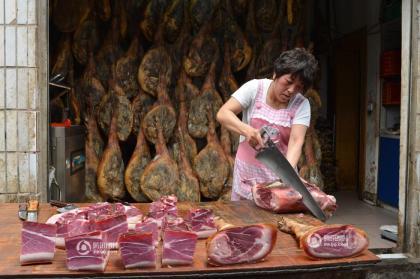
Xuanwei Han in Xuanwei City. Reference China on the Way.
Yunnan is one of China’s premium food regions known for exquisite tastes. One of the major cities in this picturesque region is Xuanwei, where one of the world famous Chinese hams are produced, the others being Jinhua Ham from Zhejiang province and Rugao Ham from Jiangsu province. Yunnan Xuanwei Ham is known for its fragrance, appearance, and out-of-the-world taste. Through the ages, there have been many references in literature to the health benefits associated with the hams. In order to produce these hams, there are at least two ingredients without which the hams can not be produced. The first ingredient is salt.
The Industrialisation of Ham
Early references to Xuanwei hams go back to 1766. “Old chronicles recorded the Qing emperor Yong Zheng five years (the year 1727) located XuanWei (a city of YunNan province, China), so it is called XuanWei ham. (China on the Way) In 1909, Zhuo Lin’s (Deng Xiaoping’s third wife) father Pu Zai Ting, a businessman, mass-produced it for the first time. He established Xuanhe Ham Industry Company Limited. His company sent food technicians to Shanghai, Guangzhou (formerly Canton), and Japan to learn advanced food processing technology.
One example of the excellence pursued in Guangzhou relates to the cultivation of rice. Rice breeding began in China in 1906. However, by 1919, systematic and well-targeted breeding using rigorous methodologies was started at Nanjing Higher Agricultural School and Guangzhou Agricultural Specialized School. Between 1919 and 1949, 100 different rice varieties were bred and released. (Mew, et al., 2003) For a riveting look at the trade in Guangzhou, see the work by Dr. Peter C. Perdue, Professor of History, Yale University, Canton Trade.
By all accounts, Pu Zaiting was successful in creating a world famous ham (at least by probably standardising and industrialising the process). In 1915 Xuanwei ham won a Gold Medal at Panama International Fair. The ham, which, in the Qing and Ming Dynasties, was a necessary gift for friends and guests and which, during the gourmet festival, became the main ingredient to create different delicious dishes achieved international acclaim. (chinadaily.com)
The Xuanhe Canned Ham Industry Company Limited was established on the back of canning equipment bought from the United States of America to produce canned ham. Most of what it produced were exported overseas. In 1923 Sun Yat-sen tasted the ham at the National Food Exhibition held in Guangzhou. Sun famously wrote of the ham, “yin he shi de” translating as “eat well for a sound mind!” By 1934, four companies were producing the canned ham. (Kristbergsson and Oliveira, 2016)
Xuanwei Ham expanded greatly under the People’s Republic of China, established in 1949. Supporting industries started to develop. A factory was created to supply the cans used by the Municipal Authority of Kunming City. (Kristbergsson and Oliveira, 2016)
Production of Xuanwei hams rose by 1999 to 13 000 tonnes, made by 38 large producers. In 2001 it got the status of a regional brand, protected by the People’s Republic of China. A Chinese standard, GB 18357-2003 was subsequently issued. By 2004 production rose to 20,750 tonnes with technology in manufacturing and packaging improving continuously. (Kristbergsson and Oliveira, 2016)
Apart from a rich and competitive environment, an entrepreneur, as the proverb goes, worth his salt, was needed to bring discipline to the production process and to establish this ham among the finest on earth. In achieving this status, three elements were required, namely salt, the right meat and a solid production technique to yield this culinary masterpiece on an industrial scale.
Yunnan – Centre of Culinary Excellence
The first requirement for competitiveness is an environment of excellence and innovation. The environment where this exquisite ham is produced testifies to culinary excellence. Like Prague, which produced the ham press, nitrite curing and the famous Prague hams, the Yunnan hams likewise hail from an area replete with food and cooking innovations. Yunnan is located on what was known as the Southern Silk Road and its culinary excellence is seen, among other things, in the equipment used in preparing their foods. Joseph Needham, et al. reports that in restaurants in the cities of Yunnan, a very special dish is found “in which chicken, ham, meat balls and the like have been cooked in water just condensed from steam. This is done by means of an apparatus called chhi kuo (or formerly yang li kuo) made especially at Chien-shui near Kochiu. It consists simply of a red earthenware pot with a domical cover, the bottom of the pot being pierced by a tapering chimney so formed as to leave on all sides an annular trough (figure 1490). The chhi kuo once placed on a saucepan of boiling water, steam enters from below and is condensed so as to fall upon and cook the viands of the trough, resulting thus after due process in something much better than either a soup or a stew in the ordinary sense. Since the chimney tapers to a small hole at its tip no natural volatile substances are lost from the food, hence the name of the object and the purpose of its existence. The chhi kuo must claim to be regarded as a distant descendant of the Babylonian rim-pot (for it has and needs no Hellenistic side-tube) with the ancient rim expanded to form a trough, compressing the ‘still’-body to a narrow chimney. But how the idea found its way through the ages, and from Mesopotamia to Yunnan, might admit of a wide conjecture.” (Needham, et al.,1980)
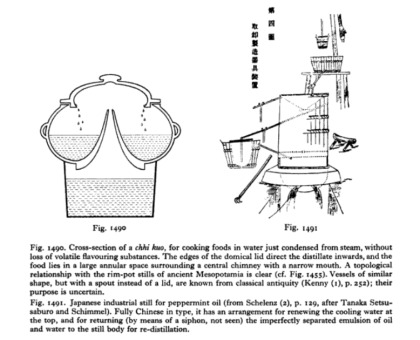
The second essential ingredient for a salt-cured ham is salt. Salt is something that China has been specialising in for thousands of years and which became the backbone of the creation of this legend.
Salt in China
Flad, et al. (2005) showed that salt production was taking place in China on an industrial scale as early as the first millennium BCE at Zhongba. “Zhongba is located in the Zhong Xian County, Chongqing Municipality, approximately 200 km down-river along the Yangzi from Chongqing City in central China. Researchers concluded that “the homogeneity of the ceramic assemblage” found at this site “suggests that salt production may already have been significant in this area throughout the second millennium B.C..” Significantly, “the Zhongba data represent the oldest confirmed example of pottery-based salt production yet found in China.” (Flad, et al.; 2005)
Salt-cured Chinese hams have been in production since the Tang Dynasty (618-907AD). First records appeared in the book Supplement to Chinese Materia Medica by Tang Dynasty doctor Chen Zangqi, who claimed ham from Jinhua was the best. Pork legs were commonly salted by soldiers in Jinhua to take on long journeys during wartime, and it was imperial scholar Zong Ze who introduced it to Song Dynasty Emperor Gaozong. Gaozong was so enamored with the ham’s intense flavour and red colour he named it huo tui, or ‘fire leg’. (SBS) An earlier record of ham than Jinhua-ham is Anfu ham from the Qin dynasty (221 to 206 BCE).
In the middle ages, Marco Polo is said to have encountered salt curing of hams in China on his presumed 13th-century trip. Impressed with the culture and customs he saw on his travels, he claims that he returned to Venice with Chinese porcelain, paper money, spices, and silks to introduce to his home country. He claims that it was from his time in Jinhua, a city in eastern Zheijiang province, where he found salt-cured ham. Whether one can accept these claims from Marco Polo is, however, a different question.
Salt Production In and Around Yunnan
When it comes to salt, only a very particular variety is called on to create this legend.
Yunnan-Guizhou Plateau
Around the Yunnan-Guizhou plateau are three salt producing areas which took advantage of the expansion of China towards the west in the early modern era. “Szechwan with a slow but steady advance; Yunnan with the speed and initiative characteristic of a developing mining area; Mongolia with a sudden, temporary eruption.” (Adshead, 1988) As fascinating as Szechwan and Mongolia are, we leave this for a future consideration and hone in on Yunnan.
Szechwan not only supplied its own requirements for salt, but also that of Kweichow, Yunnan (trade started in 1726) and western Hupei. Despite the fact that Yunnan imported salt from Szechwan and possibly from Kwangtung, this was mainly to supply its eastern regions of the escarpment. On the plateau it had salt resources of its own. By 1800, it is estimated that it produced 375 000 cwt (hundredweight).”These salines formed three groups: Pei-ching in the west near Tali the old indigenous capital; the Mo-hei-ching or Shihi-koa ching in the south near Szemao close to Laotian and Burmese borders; Hei-ching in the east near the provincial capital Kunming. (Adshead, 1988) It is this last group that captures our imagination due to the connection with the Yunnan hams.
Although known as ching or wells, many of the Yunnan salines, especially those in the Mo-hei-ching group, were in the nature of shafts or mines, though the low grade rock salt was generally turned into brine and evaporated over wood fires. The growth of the Yunnan salines in the Ch’ing period was the product of two forces. First, Chinese mining enterprise, often Chinese Muslim enterprise, which in the 18th century was turning Yunnan into China’s major source of base materials – copper, tin and zinc. Second, the extension of direct Chinese rule into the area, the so-called kai-t’u kuei-liu, initiated particularly by the Machu governor-general O-er-t’ai between 1725 and 1732. (Adshead, 1988)
The distant past of Heijin comes to us, courtesy of Yunnan Adventure Travel, who writes that “the unearthed relics of stones, potteries, and bronze wares have proved that as early as 3,200 years ago, ancestors of some minority groups already worked and multiplied on this land. It’s recorded in the “Annals of Heijin” that, a local farmer lost his cattle when grazing on the mountain, he finally found his black cattle near a well; but to his surprise, when it lipped the soil around the well, salt appeared; thus in order to memorize the black well, the place was nicknamed as “Heiniu Yanjin” which means the black cattle and the salt well. It’s shortly referred to as Heijin afterwards.” (www.yunnanadventure.com) Some accounts of the story have it that it was a Yi girl who was looking for her missing oxen when she came upon them licking salt from the black well.
Who better to take us on a tour of the old town than a seasoned traveller! We meet such a wanderer in the old city of Heijin in the person of Christy Huang. She takes us on an epic adventure, discovering the old salt kingdom of Hei-ching. She posted it on Monday, November 30th, 2015 and she called her post “Old Towns of Yunnan, Heijing.”
Christy writes that “the quite fameless Old Town of Heijing (黑井古镇) – today one of the nicest in Yunnan – used to be famous for the high-quality salt which was produced there since hundreds of years. The once most important town of Yunnan is hidden at the banks of Longchuan River in Lufeng County of Chuxiong Prefecture of Yunnan.
Salt production in bigger scale began in the Tang Dynasty (618-907) and peaked during the Ming (1368–1644) and Qing (1644–1912) Dynasties. Besides the overall beautiful picture of Hejing and its surroundings, there are a couple of scenic spots worth mentioning:
Courtyard of Family Wu,
Ancient Salt Workshop,
Dalong Shrine, as well as,
Heiniu Salt Well.
The Courtyard of Family Wu used to be the residence of former salt tycoon of Heijing Old Town. The mansion was built during 21 years in mid 19th century and is formed in the shape of the Chinese character wang (王), which means king. It has 108 rooms, which have been left more or less unchanged. Today it serves as an (expensive) hotel for Heijing visitors.
The Ancient Salt Workshop was Heijing’s core place and fortune fountain. The remaining huge water wheels and stages for making salt testify the great prosperity of the bygone times. The salt produced in Heijing is as white as snow. It was and is used for preserving Yunnan’s well-known Xuanwei Ham.” (Christy Huang, 2015)
Wujin pig
The third ingredient in the production of Yunnan Xuanwei Ham is the pigs. Traditionally, the rear legs of the Wujin pig breed are used. The breed is known for its high-fat content, muscle quality and thin skin (chinadaily.com).
The breed is usually kept outdoors and is typical in the Xuanwei region. They are normally fed on corn flour, soybean, horse bean, potato, carrot, and buckwheat. They are slow growers, but their meat is of superb quality.
Li Yingqing and Guo Anfei (China Daily) wrote a great article about these pigs for the Yunnan China Daily entitled “Yunnan’s little black pig by the Angry River.”
They write that “there is a quiet little revolution taking place by the banks of Nujiang River, the “angry river”, the upper stretch of the famous Mekong as it passes the narrow gorges near Lijiang. Here, little black pigs wander freely by steep meadows, grazing on wild herbs and foraging as freely as wild animals. They are relatively small, compared to their bigger cousins bred in farms. These sturdy little animals are reared for about two to three years before they are slaughtered and made into the region’s organic hams – called black hams for their deep-colored crusts.” (Yingqing and Anfei)
Li Yingqing and Guo Anfei report on “Wang Yingwen, a 47-year-old farmer who has raised the black pigs for more than 30 years, says the pigs are fed spring water and they live on wild fruits, mushrooms and ants on mountains, an all-organic diet if there was one. (Yingqing and Anfei)
With increased industrialisation came the demand for a faster growing animal. Wujin pigs were being crossed with Duroc (USA), Landrace (Denmark), and York (UK) to achieve faster growth. Wujin x Duroc were crossbred. Other crossbreeds are York x (Wujin x Duroc) and DLY (Duroc x (Landrace x York). Yang and Lu (1987) found that the cross itself does not materially influence the quality of the ham as long as the breed contains 25% Wujin blood. (Kristbergsson and Oliveira, 2016)
In Xuanwei City, pig production is big business! In 2004, the city loaned 120 million yuan to breeders. By this date, the city had 31 breeding facilities each yielding 3000 pigs annually. There were an additional 9600 small breeding facilities. 356 Animal hospitals support the breeding and husbandry operations. In Xuanwei City, 1.2 million pigs were sold in that year. (Kristbergsson and Oliveira, 2016)
Consumers want a great product (consistency, despite volumes offered by industrialised processes) and a great story (focussing on the ancient history of the process and ham itself). Work to accomplish this was funded by the Yunnan Scientific Department, the Yunnan Education Department and Xuanwei City Local Government who all promoted the continued development of the Yunnan Xuanwei Ham (宣威火腿/xuān wēi huó tuǐ). (Kristbergsson and Oliveira, 2016) Modern processing methods moved away from seasonal production and embraced modern processing technology, but the great legends of the past remain as well as tailor-made production techniques catering for year-round production.
Processing Yunnan Xuanwei Ham
The Xuanwei climate explains the production methods used, as is the case with all the great hams around the world. Xuanwei City is located on a low-latitude plateau mansoon climatic area where the north sub-torrid zone, the southern temperature zone, and the mid-temperature zone coexist. Winter lasts from November to January and spring occurs from February to April. February, March, April is sunny and clear and this leads to a low relative humidity during these months. From March to September it is overcast and rainy, and the relative humidity is comparatively high. Winter is the best time to salt the hams according to the old methods to limit microactivity till salt dehydrates the meat and reduces the water activity. The rainy season is best for fermenting the ham. (Kristbergsson and Oliveira, 2016)
Production
As in all meat processing, making the hams start with good meat selection. The process starts in the winter. The animal is killed and all the blood pressed out by hand. Animals are between 90 and 130 kg (live weight) when slaughtered.
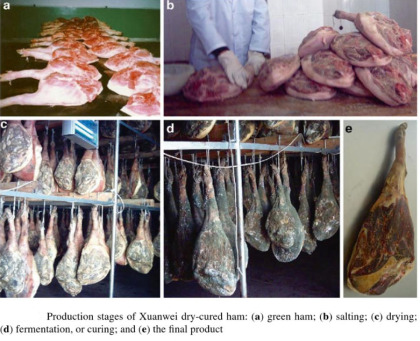
by Kristbergsson and Oliveira, 2016
A simple flow chart is given by Kristbergsson and Oliveira (2016).
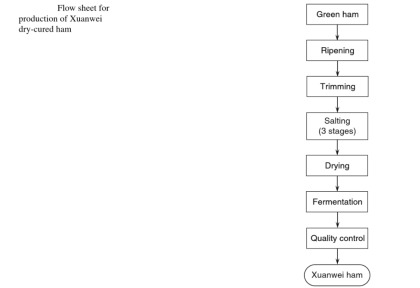
Slaughtering and Trimming

Boiling water and scraping the pig’s hair. Reference: China on the Way.
Traditionally Xuanwei people kill the pigs usually before the last frost. They add boiling water to a wok and scrape the pig’s hair. Some people refer to killing the pig as washing the pig. For villagers, the killing of the pig is a sacred ceremony. (China on the Way)
The hind leg is trimmed into an oval shape in the form of a Chinese musical instrument, the pipa. The legs of small pigs are cut in the form of a leaf. The legs cut off along the last lumbar vertebra. After the blood is pressed out, the meat is held for ripening in a cold room at a temperature of 4 to 8 deg C, relative humidity of 75% for 24 hours. Ripened legs are known as green hams. (Kristbergsson and Oliveira, 2016) This step is an enigma to me since I am not sure what is accomplished in such a short period of time. My guess is that it is not technically ripening, but rather allowing any excess fluids to drain out. I will keep interrogating the processing steps to ensure that my sources have the right information.
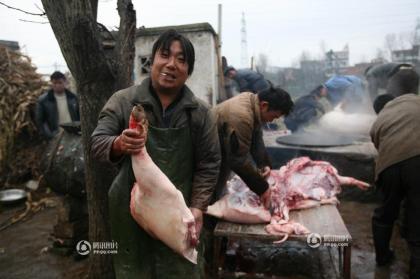
Cutting and trimming the leg: China on the Way.
Salting
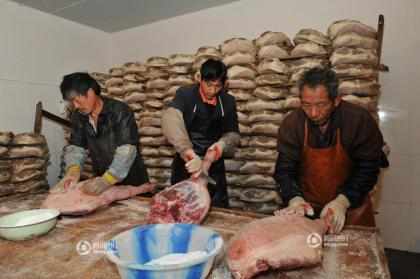
The First Salting: China on the Way.
The green hams are then salted. The salt is a mixture of table salt (25g/kg of leg) and sodium nitrite (0.1g/kg leg). (Kristbergsson and Oliveira, 2016) The inclusion of sodium nitrite is without question a modern development since nitrite curing of meat only became popular after World War I. My instinct tells me that they originally only used salt and later, possibly, sodium nitrate, the production of which has been done for very long in Chinese history.
The salt is rubbed into the hams by hand massaging for around 5 minutes. “The salted hams are then stacked in pallets and held in a cold room at 4 to 8 deg C, 75 to 85% relative humidity for 2 days. Salting procedure is then repeated.” The salt ratios are this time changed to table salt of 30g/kg ham and sodium nitrite is kept at 0.1g/kg leg. The meat is rested for a further 3 days in the chiller after which another salting is done. The ratio of this salting is 15g of table salt per kg of ham and again, sodium nitrite is kept at 0.1g per kg ham. (Kristbergsson and Oliveira, 2016)
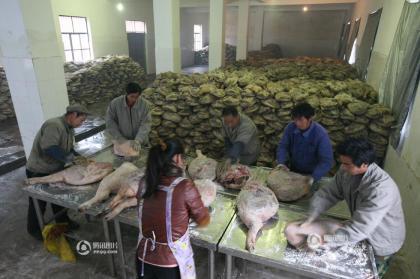
Kneeing the hams as salt is rubbed in by hand: China on the Way.
According to Li Yingqing and Guo Anfei, “traditionally made hams are cured with half the salt used in factories. Instead, they are allowed to dry-cure for at least eight months to about three years, so the meat has time to mellow and mature.” “The longer the ham is cured, the better the quality and the most popular product now is the three-year-old cured ham.”
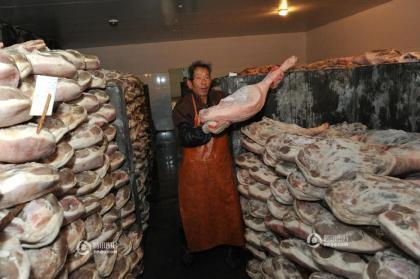
Double Salted Hams: China on the Way.
Drying
The hams are then hung in the drying room with a temperature of 10 to 15 deg C and relative humidity of between 50 and 60%. (Kristbergsson and Oliveira, 2016) Note how the temperature is increased and the relative humidity decreases to facilitate drying from the inside, out.
The excess salt is brushed away and the hams are dried for 40 days. Windows are kept open to facilitate air movement to air drying. Screens are placed in front of openings to prevent flies, other insects and birds from entering. If drying is too fast, a crust will form on the outside of the ham and if it is done too quick, the inside will not be dried and will spoil. If drying is done too long, the meat will be too dry to accommodate the lactic acid bacteria which will be involved in the fermentation process.
Li Yingqing and Guo Anfei reports on the traditional way that drying was done. “If you visit the villages by Nujiang, you may chance upon a strange sight in winter, when the hams are hoisted high on trees so they can catch the best of the drying winds. These trees with hocks of ham hanging from them seem to bear strange fruit indeed.”
Fermentation

Drying and Fermentation: China on the Way.
After drying, the temperature is raised to 25 deg C. Relative humidity is pushed up to 70% and ideal conditions are created for fermentation. This process lasts for 180 days. Apart from creating an ideal condition for microbes, raising the temperature and humidity favours enzymatic activity, which is important in flavour development due to the partial decomposition of lipids (fat) and proteins. (Kristbergsson and Oliveira, 2016)
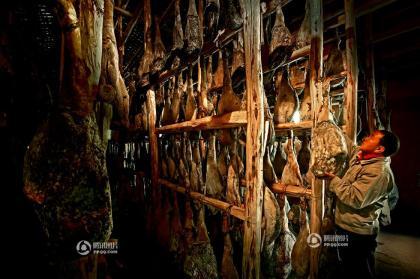
Traditionally, the fermentation process takes more than ten months. When the surface is completely green, the hams are ready: China on the Way.
Aging
“Xuanwei ham is like good wine: the older the better. A ham that’s been aged at least 3 years can be eaten raw like prosciutto di parma.”
Control of Pests
During the curing and drying stages, flies pose a major risk. During fermentation and storage ham moths and mites (eg. tyrophagus putrescentiae) are the major danger. Relative humidity of over 80% attracts flies such as Piophila casei, Dermestes carnivorus beetle and mites. “There has been considerable work done in controlling mite infestation. Microorganisms such as the Streptomyces strain s-368 help prevent and treat mite investigation.” (Kristbergsson and Oliveira, 2016)
Evaluation
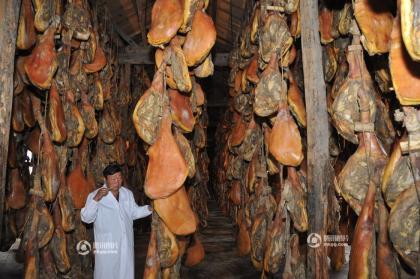
Bone needles or bamboo needles are used to insert it into three specific sites to check the ham. The smell tells the evaluator if the ham is ready: China on the Way.
Xuanwei hams are evaluated by sensory evaluation. The odor is absorbed by a bamboo stick, used for the evaluation. This is the most traditional absorption method to classify different ham grades. For a detailed discussion and evaluation of this method, see Xia, et. al (2017), Categorization of Chinese Dry-Cured Ham Based on Three Sticks Method by Multiple Sensory Techniques
Storage
Storage is done under ambient conditions and the hams can be stored between 2 and 3 years.
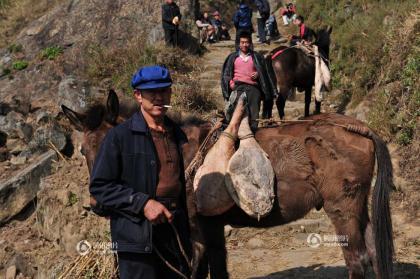
A caravan travelling along an ancient road. Pu Zaiting must have been driving just such a caravan, journeying from north and south: China on the Way.
Physiochemical Indices

by Kristbergsson and Oliveira, 2016
“The physical and chemical properties of dry-cured ham are important determinants of its quality (Jiang et al. 1990 ; Careri et al. 1993 ). The lean portion of Xuanwei ham contains 30.4 % protein, 10.9 % fat, 10.3 % amino acids, 42.2 % moisture, and 8.8 % salt (Jiang et al. 1990 ). The whole ham contains 17.6 % protein, 29.1 % fat, 5.6 % amino acids, 24.8 % moisture, and 3.3 % salt (Jiang et al. 1990 ). Many essential elements are present in the ham as are some vitamins. The ham is particularly rich in vitamin E (45 mg/100 g). The characteristic bright red color of Xuanwei ham is mainly attributed to oxymyoglobin and myoglobin. The flavor and taste are associated with the presence of various amino acids and volatile organic compounds . The volatile substances present in Xuanwei ham have been extensively studied (Qiao and Ma 2004 ; Yao et al. 2004 ). Seventy-five compounds were tentatively identified in the volatile fraction. The compounds identified included hydrocarbons, alcohols, aldehydes, ketones, organic acids, esters, and other unspecified compounds.” (Kristbergsson and Oliveira, 2016)
Microflora
The dominant microorganism on the surface of dry cured hams is mold, which affects quality. During the ripening stage, molds play an important and positive role in flavour and appearance. A study of Iberian dry-cured hams showed that yeasts are predominant during the end of the maturing phase of production whereas Staphylococcus and Micrococcus are absent. This surface yeast population has been shown to be useful for estimating the progress of maturation. Its contribution to curing is suggested to be their proteolytic or lipolytic activity. (Kristbergsson and Oliveira, 2016)
In Xuanwei hams, researchers have shown Streptomyces bacteria to dominate and account for almost half of the Actinomycetes. Aspergilli and Penicillia are common on the surface of Xuanwei hams during June to August. They found 8 species of Aspergillus. A. fumigatus was found to be dominant and accounts for one third of Aspergilli. Generally speaking, a high relative humidity encourages mold development on the surface of the hams. (Kristbergsson and Oliveira, 2016)
The dominant fungi found on Xuanwei hams is yeast. Yeast can be 50% of the total microorganisms found on mature dry-cured hams. Proteolytic and lipolytic activity of yeast is desirable. Towards the end of maturation, yeast dominates on dry-cured hams. (Kristbergsson and Oliveira, 2016)
Which species to be found during the different stages of production depends on temperature and relative humidity. In the Xuanwei region, humidity and temperature are highest during the rainy season. Molds occur almost exclusively on the surface of the hams. Aspergilli and Penicillia occur mostly during May when relative humidity and temperature are high. These fungi peak in July and August. Molds begin to grow in May and are well established by June. Spores are formed in August and September. The quantity of spores falls off gradually in September. (Kristbergsson and Oliveira, 2016)
“The growth of bacteria and Actinomycetes does not seem to be dependent on humidity in the curing room. Levels of bacteria are generally lower than levels of yeast. According to Wang, et al. (2006) yeast on ham multiplies exponentially from the beginning of the salting stage to reach a peak in April, and then the numbers drop and stabilise to around 2 x 107 cfu/g.Yeast levels within the ham show similar variation as the surface yeast. According to Wang et al. (2006) yeast accounts for 60 to 70% of the total microbial population on the surface of the ham. In some cases, no molds have been found growing on the surface of good-quality ham; therefore, some researchers believe that molds do not play a direct role in determining the quality of dry-cured ham, but an opposing view also prevails.” (Kristbergsson and Oliveira, 2016)
“According to the traditional view, high quality Xuanwei ham must have “green growth” (i.e. molds) on it. However, fungi such as Penicillia , Fusarium , and Aspergilli are known to produce mycotoxin in foods such as dry-cured Iberian ham (Núñez et al. 1996 ; Cvetnić and Pepeljnjak 1997 ; Brera et al. 1998 ; Erdogan et al. 2003 ). More than 15 % of the mold strains examined were found to produce mycotoxins in Xuanwei ham (Wang et al. 2006 ). The toxins penetrated to a depth of 0.6 cm in the ham muscle. Because most of the fungi that occur on ham have not been examined for producing mycotoxins , contamination with toxins might be more prevalent than is realized.” (Kristbergsson and Oliveira, 2016)
Feasting
“The ham must be flame burned and washed before eating, in order to remove the rancid taste.” (China on the Way.)
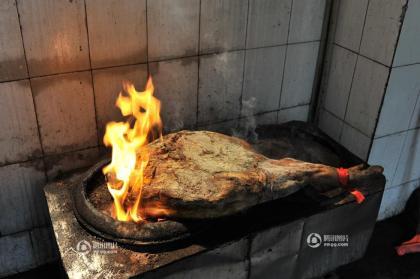
Flame treatment: China on the Way.
There are an infinite variety of ways to serve the ham. It can be steamed, boiled, fried, or used as accessories. Old legs can be eaten raw. When cooking, cook either the whole ham or large cuts on a slow fire or slow boil it to retain the flavour.
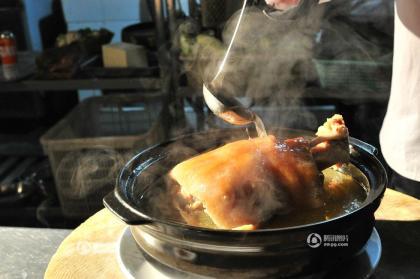
China on the Way.
Further Reading
Traditional Foods, Kristbergsson, K., Oliveira
—————————————————————–
Reference
Adshead, S. A. M.. 1992. Salt and Civilization. Palgrave.
chinadaily.com Updated: June 26, 2019
China on the Way, XuanWei Ham
Flad, R., Zhu, J., Wang, C., Chen, P., von Falkenhausen, L., Sun, Z., & Li, S. (2005). Archaeological and chemical evidence for early salt production in China. Proceedings of the National Academy of Sciences of the United States of America, 102(35), 12618–12622. http://doi.org/10.1073/pnas.0502985102
Huang, Christy. 2015. Old Towns of Yunnan, Heijing.
Kristbergsson, K., Oliveira, J. (Editors). 2016. Traditional Foods: General and Consumer Aspects. Springer.
Mew, T. W., Brar, D. S., Peng, S., Dawe, D., Hardy. B. (Editors). 2003. Rice Science: Innovations and Impact for Livelihood. International Rice Institute (IRRI).
Needham, J., Ping-Yu, H., Gwei-Djen, L.. 1980. Sivin, N.. Science and Civilisation in China: Volume 5, Chemistry and Chemical Technology. Cambridge University Press.
SBS – http://www.sbs.com.au/food/article/2017/04/30/over-1000-years-ham-heres-where-it-all-began
http://www.yunnanadventure.com/index.php/Attraction/show/id/153.html
https://yunnan.chinadaily.com.cn/2012-01/16/content_14500704.htm
http://www.chinaontheway.com/xuanwei-ham/?i=1
Xia, D., Zhang, D. N., Gao, S. T., Cheng, L., Li, N., Zheng, F. P., Liu, Y.. 2017. Categorization of Chinese Dry-Cured Ham Based on Three Sticks Method by Multiple Sensory Techniques Volume 2017, ID 1701756 https://doi.org/10.1155/2017/1701756
Yunnan Xuanwei Ham (宣威火腿/xuān wēi huó tuǐ) Yunnan Xuanwei Ham (宣威火腿/xuān wēi huó tuǐ) Eben van Tonder 10 May 2020 Introduction Yunnan is one of China's premium food regions known for exquisite tastes.
0 notes
Photo

Blog 1: Introduction - What is Haringey has Pride?
Jacksons Lane presents Haringey Has Pride which is funded by the Heritage Lottery Fund and supported through partnerships with Wise Thoughts, Homes for Haringey, Chocolate Films and Alexandra Palace. It celebrates the 1980’s LGBTQ heritage of Haringey, and promotes equal rights socially and politically. Section 28 legislation was part of the local government act 1988, brought in by Margret Thatcher, and was a controversial law which band the promotion of same sex relationships. Haringey Council took a strong stand against this with its’ own “Positive Images” campaign through a 1987 North London Pride Festival, much of which took place in Tottenham and Wood Green.
This is where fringe groups formed to support similar and associated causes against the section 28 legislation with a Haringey Council and Gay Unit supporting LGBTQ people. A bookstore called Reading Matters selling materials supporting LGBTQ communities and was the center of a large campaign to save the space when faced with closure.
This was a very powerful time for LGBTQ activism in the borough having a national impact but there is danger this heritage is getting lost. Haringey Has Pride is vital in educating Haringey residents about the important role the borough has played in LGBTQ rights and awaken a new energy for LGBTQ awareness. Haringey Has Pride seeks to by recreating the 1989 Haringey Pride with workshops, events and exhibitions highlighting the LGBTQ+ communities achievements, a reminisce documentary capturing the lived experiences of 80’s LGBTQ+ heritage in Haringey in partnership with Chocolate Films and Homes for Haringey and a community play made in partnership with Alexandra Palace, professional theatre maker Kay Adshead and a cast of community members, inspired by this LGBTQ+ history. These events aim to bring everyone together to teach the community about key moments of the heritage.
0 notes
Text


Wuthering Heights ep. 3 (1978) dir. Peter Hammond
#thanks to this series for fulfilling my dream of seeing kate bush as catherine earnshaw#but really she’s the best adult catherine you can possibly imagine#straight out of the novel I swear#wuthering heights#wuthering heights 1978#kay adshead#catherine earnshaw#serie tv#emily bronte#fiori#edit#wh edits
19 notes
·
View notes
Photo







Wuthering Heights ep. 2 (1978) dir. Peter Ammond
#montage in every wh adaptation when they grow up my beloved#wuthering heights 1978#wuthering heights#kay adshead#ken hutchison#catherine earnshaw#heathcliff#edit#serie tv#emily bronte#letteratura#wh edits
17 notes
·
View notes
Photo


Nelly, do you ever dream queer dreams?
#wuthering heights#wuthering heights 1978#emily bronte#catherine earnshaw#kay adshead#serie tv#edit#letteratura#wh edits
13 notes
·
View notes